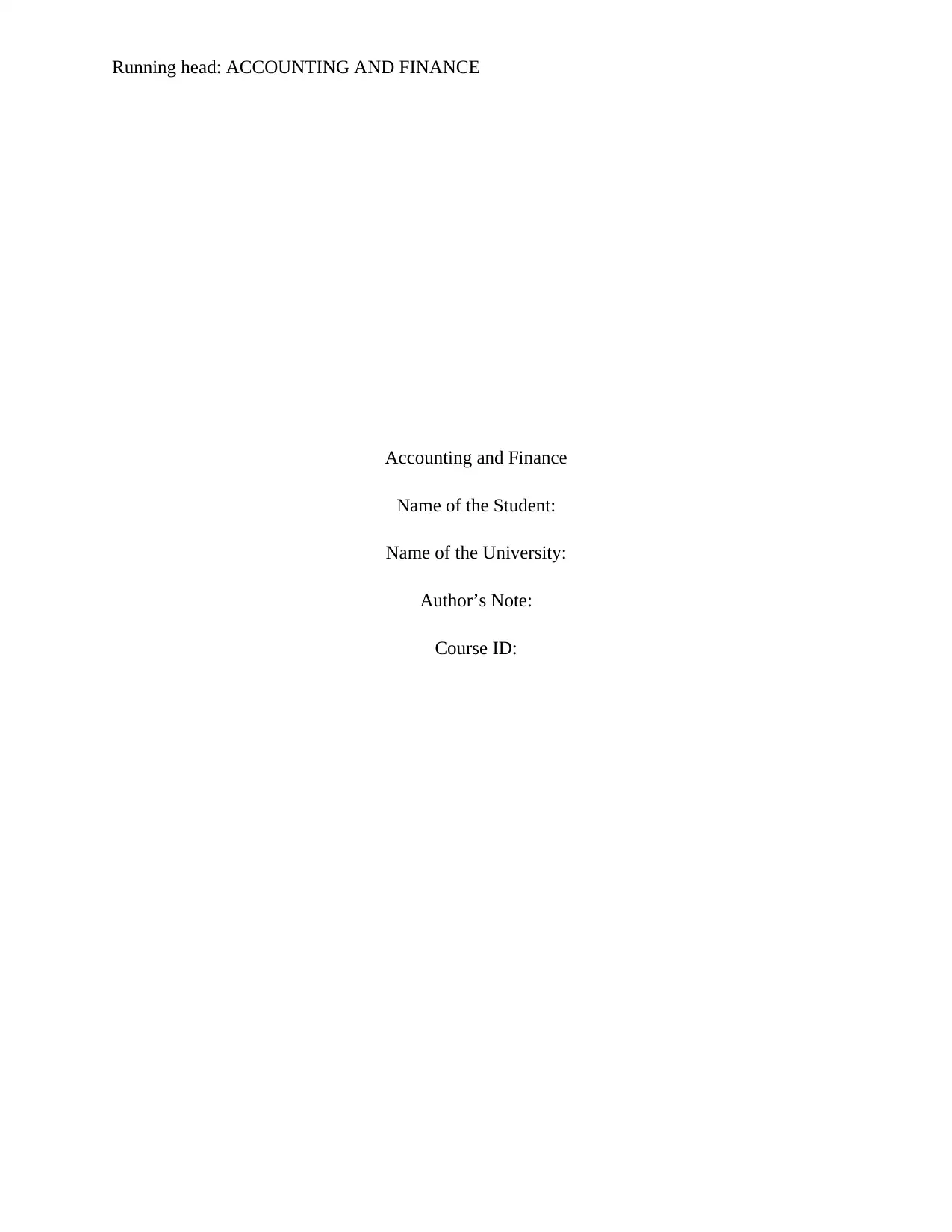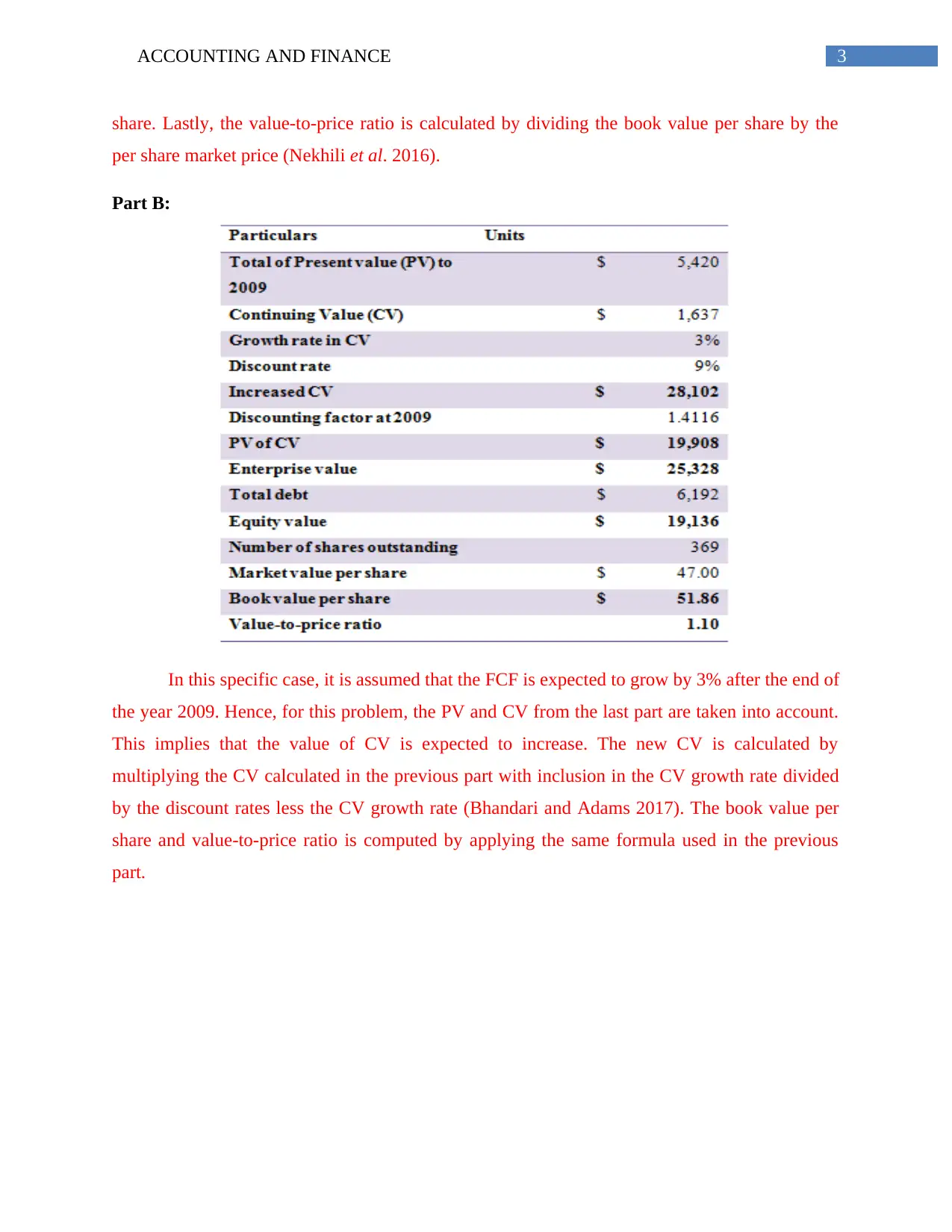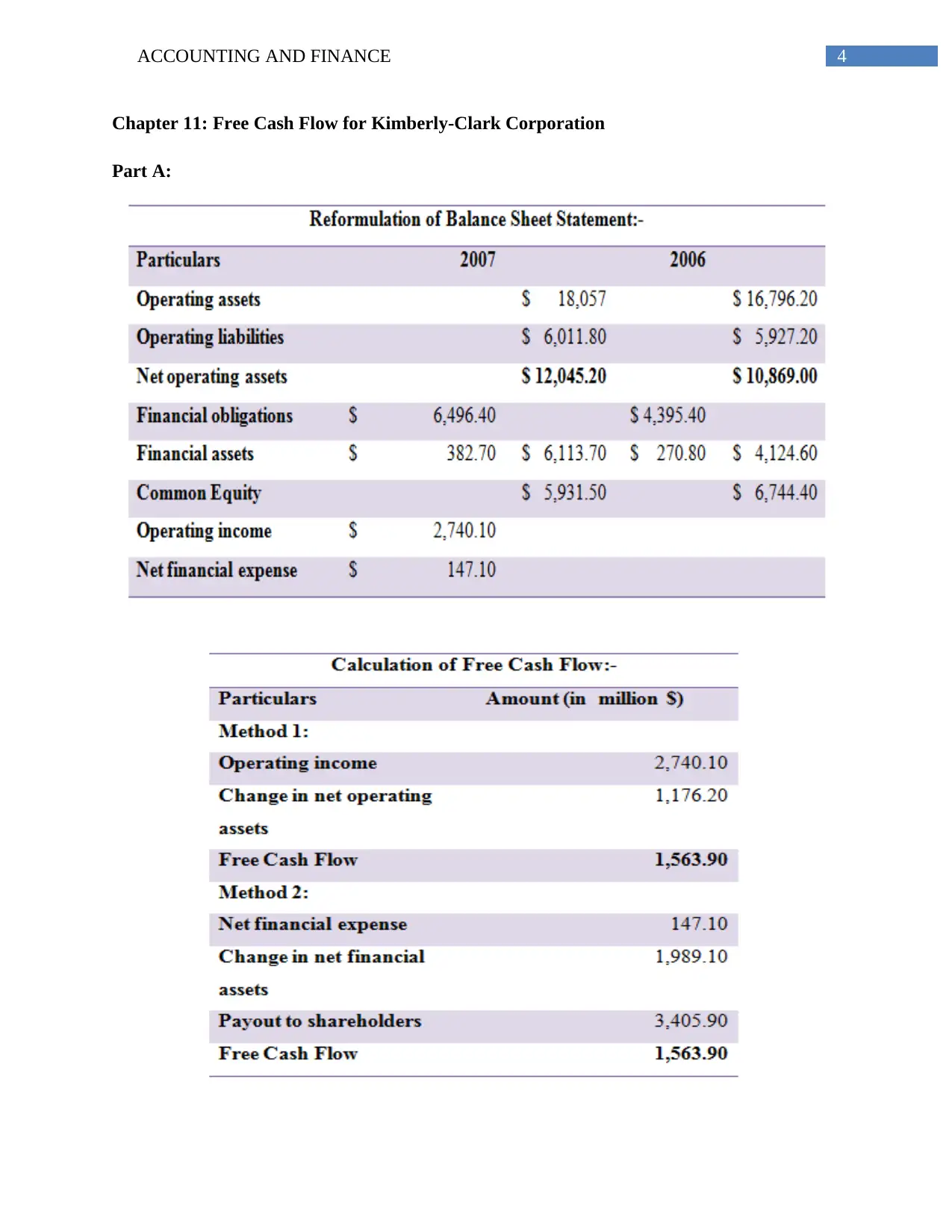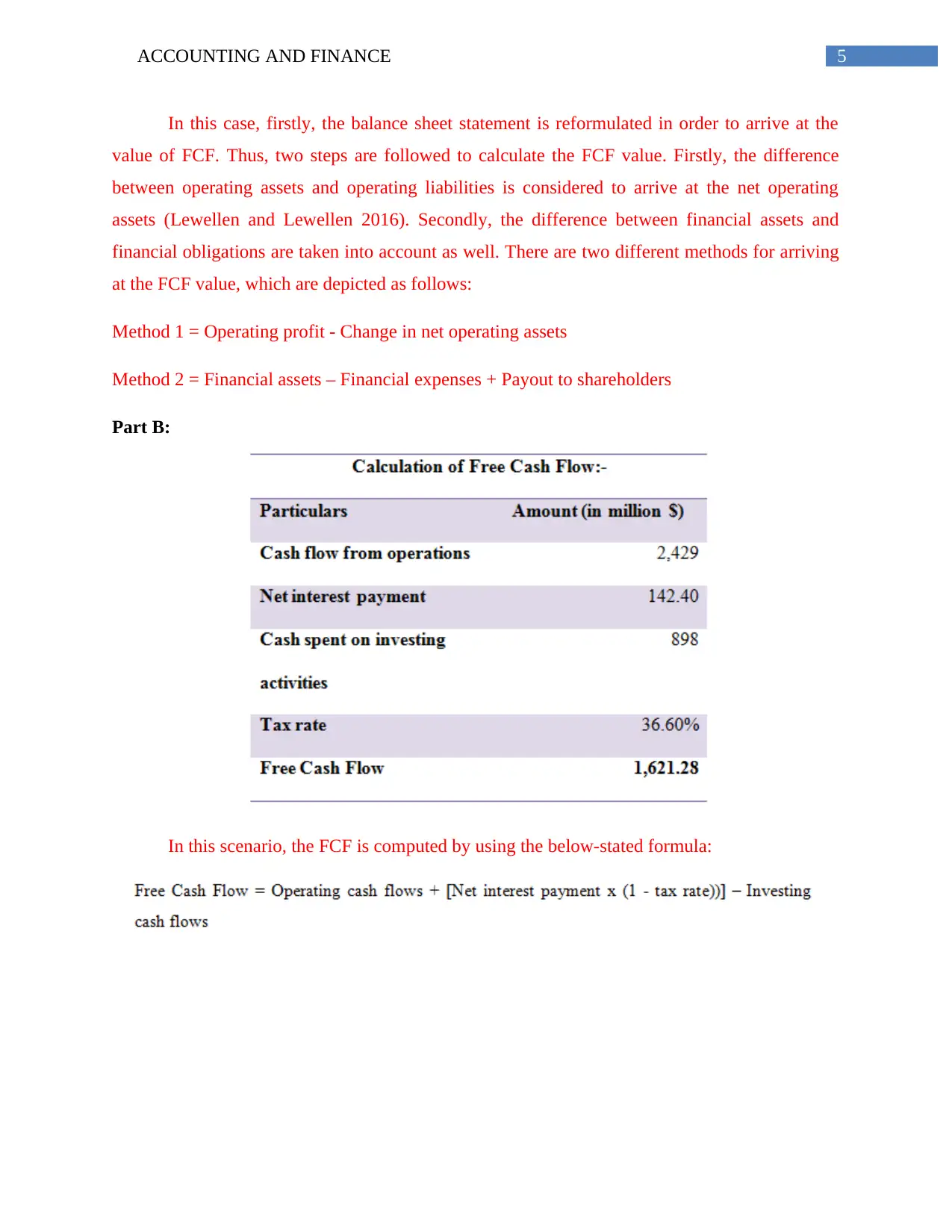Accounting and Finance Report: Cash Flow Analysis of Corporations
VerifiedAdded on 2020/05/28
|7
|844
|154
Report
AI Summary
This report provides a detailed analysis of cash flow valuation, focusing on discounted cash flow (DCF) and free cash flow (FCF) methods. It examines two case studies: General Mills, Inc., and Kimberly-Clark Corporation. The report calculates FCF, present value (PV), continuing value (CV), and enterprise value (EV) under different growth rate assumptions. It also covers the calculation of book value per share and value-to-price ratios. For Kimberly-Clark, the report reformulates the balance sheet to determine FCF using two methods: operating profit adjustments and financial asset/obligation differences. The report includes references to relevant academic literature on cash flow analysis and valuation techniques. This report is designed to aid students in understanding and applying financial modeling concepts.

Running head: ACCOUNTING AND FINANCE
Accounting and Finance
Name of the Student:
Name of the University:
Author’s Note:
Course ID:
Accounting and Finance
Name of the Student:
Name of the University:
Author’s Note:
Course ID:
Paraphrase This Document
Need a fresh take? Get an instant paraphrase of this document with our AI Paraphraser

1ACCOUNTING AND FINANCE
Table of Contents
Chapter 4: A Discounted Cash Flow Valuation: General Mills, Inc...............................................2
Part A:..........................................................................................................................................2
Part B:..........................................................................................................................................3
Chapter 11: Free Cash Flow for Kimberly-Clark Corporation........................................................4
Part A:..........................................................................................................................................4
Part B:..........................................................................................................................................5
References:......................................................................................................................................6
Table of Contents
Chapter 4: A Discounted Cash Flow Valuation: General Mills, Inc...............................................2
Part A:..........................................................................................................................................2
Part B:..........................................................................................................................................3
Chapter 11: Free Cash Flow for Kimberly-Clark Corporation........................................................4
Part A:..........................................................................................................................................4
Part B:..........................................................................................................................................5
References:......................................................................................................................................6

2ACCOUNTING AND FINANCE
Chapter 4: A Discounted Cash Flow Valuation: General Mills, Inc
Part A:
In this particular case, it is assumed that the growth rate of free cash flow (FCF) would
remain at the same level after 2009. By deducting the investing cash flows from the net cash
provided by operations, the FCF is computed for the years 2005-2009 (Astami et al. 2017). Once
the FCF computation is conducted, the values of the discounting factor for five years are
computed and then it is multiplied with the discount rate in order to arrive at the present value
(PV) until 2009. By dividing the FCF derived for 2009 by the discount rate, the continuing value
(CV) is calculated. With the help of this value, it is possible to compute the PV of CV by the
2009 discounting factor value. Based on such values, it is possible to compute enterprise value
(EV) by dividing each year FCF value and then, addition is made with CV divided by the 2009
discounting factor value.
With the provided value of total debt, total debt is subtracted from the enterprise value to
obtain the value of equity. Along with this, it has been identified that both the outstanding shares
and market value per share are given in the case study. By using this information, the equity
value is divided by the outstanding number of shares, which would provide the book value per
Chapter 4: A Discounted Cash Flow Valuation: General Mills, Inc
Part A:
In this particular case, it is assumed that the growth rate of free cash flow (FCF) would
remain at the same level after 2009. By deducting the investing cash flows from the net cash
provided by operations, the FCF is computed for the years 2005-2009 (Astami et al. 2017). Once
the FCF computation is conducted, the values of the discounting factor for five years are
computed and then it is multiplied with the discount rate in order to arrive at the present value
(PV) until 2009. By dividing the FCF derived for 2009 by the discount rate, the continuing value
(CV) is calculated. With the help of this value, it is possible to compute the PV of CV by the
2009 discounting factor value. Based on such values, it is possible to compute enterprise value
(EV) by dividing each year FCF value and then, addition is made with CV divided by the 2009
discounting factor value.
With the provided value of total debt, total debt is subtracted from the enterprise value to
obtain the value of equity. Along with this, it has been identified that both the outstanding shares
and market value per share are given in the case study. By using this information, the equity
value is divided by the outstanding number of shares, which would provide the book value per
⊘ This is a preview!⊘
Do you want full access?
Subscribe today to unlock all pages.

Trusted by 1+ million students worldwide

3ACCOUNTING AND FINANCE
share. Lastly, the value-to-price ratio is calculated by dividing the book value per share by the
per share market price (Nekhili et al. 2016).
Part B:
In this specific case, it is assumed that the FCF is expected to grow by 3% after the end of
the year 2009. Hence, for this problem, the PV and CV from the last part are taken into account.
This implies that the value of CV is expected to increase. The new CV is calculated by
multiplying the CV calculated in the previous part with inclusion in the CV growth rate divided
by the discount rates less the CV growth rate (Bhandari and Adams 2017). The book value per
share and value-to-price ratio is computed by applying the same formula used in the previous
part.
share. Lastly, the value-to-price ratio is calculated by dividing the book value per share by the
per share market price (Nekhili et al. 2016).
Part B:
In this specific case, it is assumed that the FCF is expected to grow by 3% after the end of
the year 2009. Hence, for this problem, the PV and CV from the last part are taken into account.
This implies that the value of CV is expected to increase. The new CV is calculated by
multiplying the CV calculated in the previous part with inclusion in the CV growth rate divided
by the discount rates less the CV growth rate (Bhandari and Adams 2017). The book value per
share and value-to-price ratio is computed by applying the same formula used in the previous
part.
Paraphrase This Document
Need a fresh take? Get an instant paraphrase of this document with our AI Paraphraser

4ACCOUNTING AND FINANCE
Chapter 11: Free Cash Flow for Kimberly-Clark Corporation
Part A:
Chapter 11: Free Cash Flow for Kimberly-Clark Corporation
Part A:

5ACCOUNTING AND FINANCE
In this case, firstly, the balance sheet statement is reformulated in order to arrive at the
value of FCF. Thus, two steps are followed to calculate the FCF value. Firstly, the difference
between operating assets and operating liabilities is considered to arrive at the net operating
assets (Lewellen and Lewellen 2016). Secondly, the difference between financial assets and
financial obligations are taken into account as well. There are two different methods for arriving
at the FCF value, which are depicted as follows:
Method 1 = Operating profit - Change in net operating assets
Method 2 = Financial assets – Financial expenses + Payout to shareholders
Part B:
In this scenario, the FCF is computed by using the below-stated formula:
In this case, firstly, the balance sheet statement is reformulated in order to arrive at the
value of FCF. Thus, two steps are followed to calculate the FCF value. Firstly, the difference
between operating assets and operating liabilities is considered to arrive at the net operating
assets (Lewellen and Lewellen 2016). Secondly, the difference between financial assets and
financial obligations are taken into account as well. There are two different methods for arriving
at the FCF value, which are depicted as follows:
Method 1 = Operating profit - Change in net operating assets
Method 2 = Financial assets – Financial expenses + Payout to shareholders
Part B:
In this scenario, the FCF is computed by using the below-stated formula:
⊘ This is a preview!⊘
Do you want full access?
Subscribe today to unlock all pages.

Trusted by 1+ million students worldwide

6ACCOUNTING AND FINANCE
References:
Astami, E.W., Astami, E.W., Rusmin, R., Rusmin, R., Hartadi, B., Hartadi, B., Evans, J. and
Evans, J., 2017. The role of audit quality and culture influence on earnings management in
companies with excessive free cash flow: Evidence from the Asia-Pacific region. International
Journal of Accounting & Information Management, 25(1), pp.21-42.
Bhandari, S.B. and Adams, M.T., 2017. On the Definition, Measurement, and Use of the Free
Cash Flow Concept in Financial Reporting and Analysis: A Review and
Recommendations. Journal of Accounting and Finance, 17(1), pp.11-19.
Lewellen, J. and Lewellen, K., 2016. Investment and cash flow: New evidence. Journal of
Financial and Quantitative Analysis, 51(4), pp.1135-1164.
Nekhili, M., Amar, I.F.B., Chtioui, T. and Lakhal, F., 2016. Free cash flow and earnings
management: The moderating role of governance and ownership. Journal of Applied Business
Research, 32(1), p.255.
References:
Astami, E.W., Astami, E.W., Rusmin, R., Rusmin, R., Hartadi, B., Hartadi, B., Evans, J. and
Evans, J., 2017. The role of audit quality and culture influence on earnings management in
companies with excessive free cash flow: Evidence from the Asia-Pacific region. International
Journal of Accounting & Information Management, 25(1), pp.21-42.
Bhandari, S.B. and Adams, M.T., 2017. On the Definition, Measurement, and Use of the Free
Cash Flow Concept in Financial Reporting and Analysis: A Review and
Recommendations. Journal of Accounting and Finance, 17(1), pp.11-19.
Lewellen, J. and Lewellen, K., 2016. Investment and cash flow: New evidence. Journal of
Financial and Quantitative Analysis, 51(4), pp.1135-1164.
Nekhili, M., Amar, I.F.B., Chtioui, T. and Lakhal, F., 2016. Free cash flow and earnings
management: The moderating role of governance and ownership. Journal of Applied Business
Research, 32(1), p.255.
1 out of 7
Related Documents
Your All-in-One AI-Powered Toolkit for Academic Success.
+13062052269
info@desklib.com
Available 24*7 on WhatsApp / Email
![[object Object]](/_next/static/media/star-bottom.7253800d.svg)
Unlock your academic potential
Copyright © 2020–2025 A2Z Services. All Rights Reserved. Developed and managed by ZUCOL.





